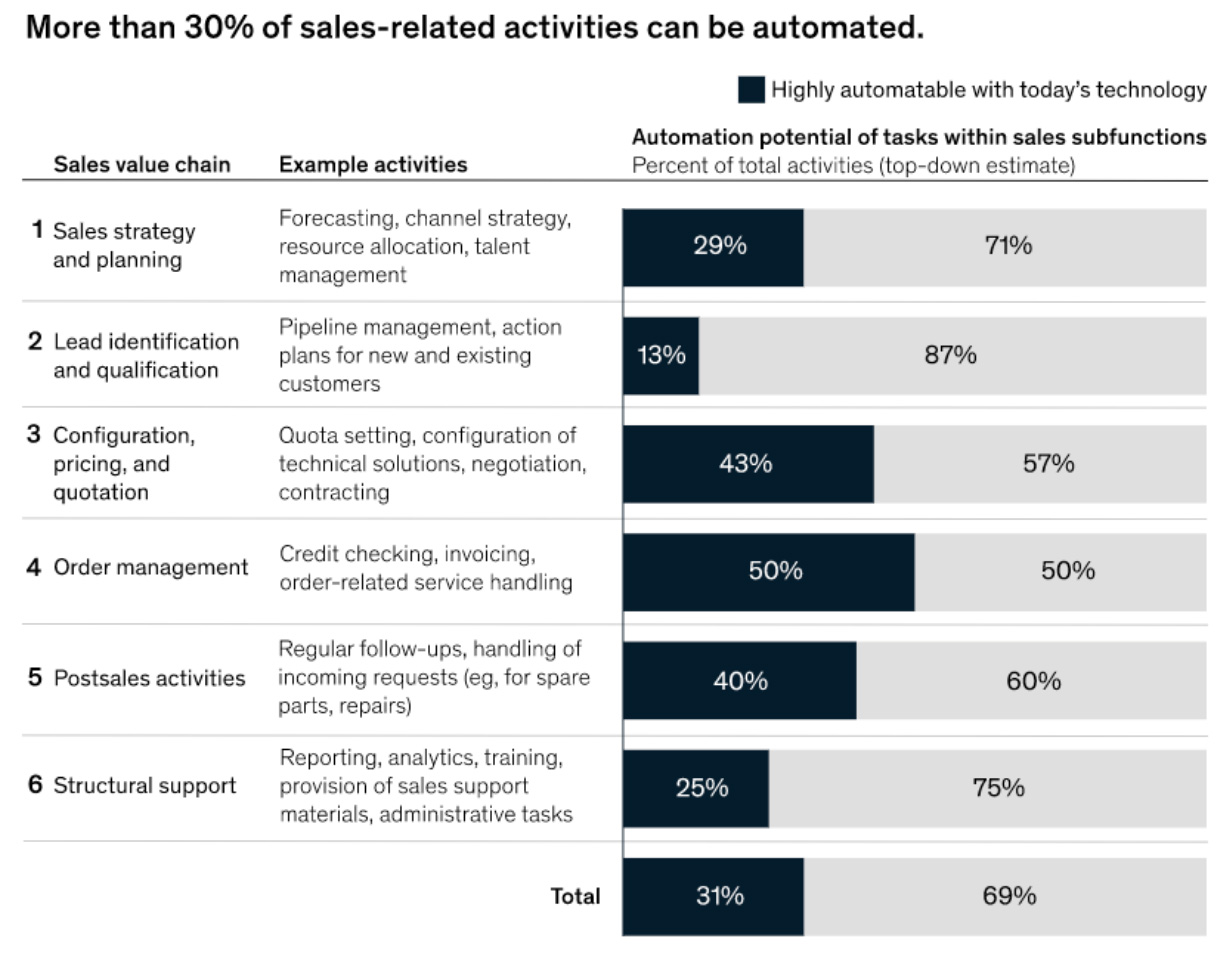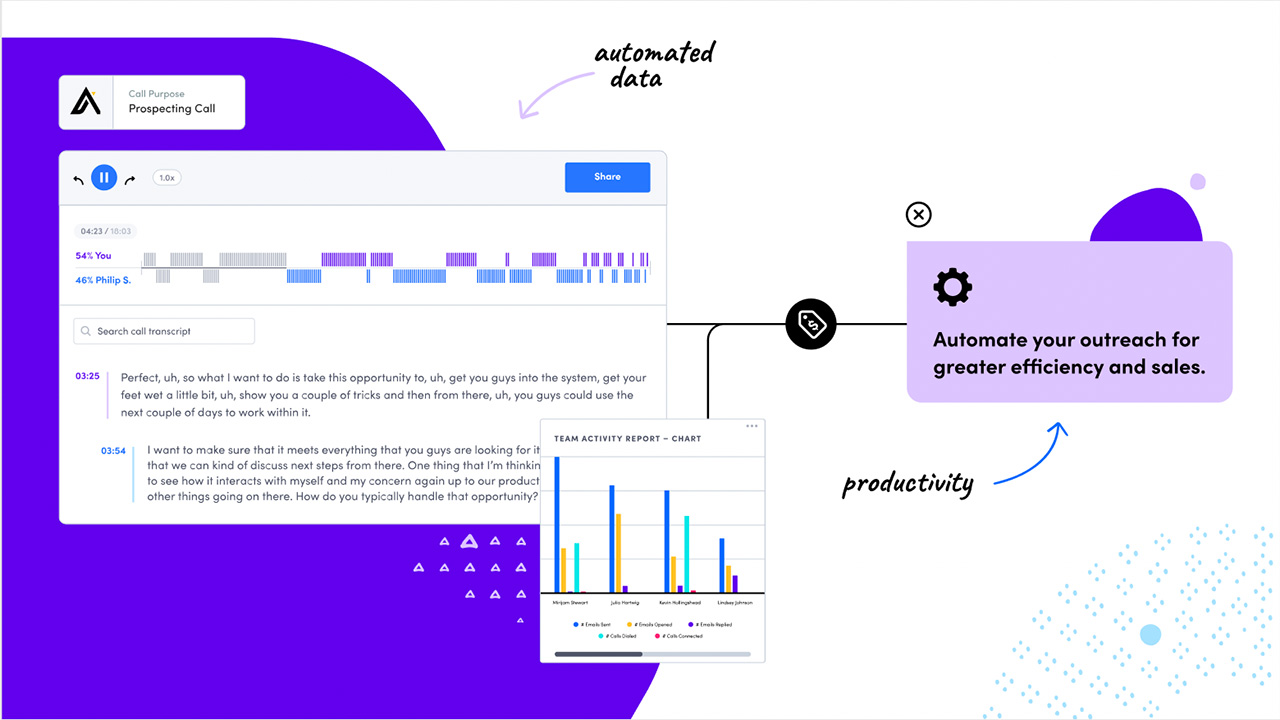The prospecting process isn’t easy.
For sales teams and representatives, it can be one of the most tedious and burdensome stages of the sales process. Dead-ends, manual data entry, time-consuming outreach, out-of-date contact information – it’s often an uphill battle from start to finish.
But, the prospecting process can also be difficult for the prospect. Today’s buyers are overwhelmed. In a world of information overload, customer attention span and confidence are rapidly dwindling. Gartner reports that B2B buyers confessed that they struggle to assess data from all of the different vendors and feel overwhelmed by the challenge of making an informed decision.
A lot of this dread surrounding prospecting comes down to a simple fact: the way businesses prospect is outdated and unsupported. Research says that nearly two-thirds of sales reps’ time is spent performing non-revenue generating activities, leaving only 35% of their time for tasks relating to prospecting and selling.
This is exactly where data can help. When data and analytics are the foundation for sales models it helps companies and salespeople understand what to focus on, when to focus on it, and with what kind of messaging.
Sounds like just what you need for prospecting?
In this guide, we’ll explain how you can use the power of data and analytics to drive your prospecting to success and how Apollo supports you in revitalizing your sales process!
A Brief Introduction to Data-Driven Sales
Data has gone from a helpful business resource to an absolutely necessary one. Twenty years ago, business was a world in which executives and decision-makers could make great decisions without explaining the science and data behind it. But today, that is no longer the case.
Data and analytics now penetrate all corners of business decision-making.
One survey showed companies using Big Data saw an 8% profit increase and a 10% reduction in cost. Successful businesses use data analytics to explain every micro-decision, and from these decisions, they gather more data, developing a continuous cycle of self-improvement. This includes improvements across revenue and production.
At its core, a data-driven sales strategy leverages data and analytics to accelerate sales. It prioritizes data gathering among sales teams and uses those insights to make strategic business decisions. Research has shown that companies who implement data-driven sales and database marketing are anywhere from 5% to 6% more profitable.
Companies that embrace data-driven sales are found to be more successful against their competitors, too! Here’s a look at a study that compares companies that use data and analytics to those that do not, in terms of where they are above their competitors.

The results speak for themselves.
Data-driven sales strategies often include:
- Well-developed Ideal Customer Profiles (ICP)
- Access to a comprehensive database
- Investment in the right tools
- Internal sales analysis
- Automation opportunities
- Predictive analytics tools
All of these elements of a data-driven sales strategy can go straight into developing strong sales prospecting. Let’s get a little more specific and examine how you can reinforce your sales strategy with prospecting data and analytics…
What is Data-Driven Prospecting?
Master prospecting and you will be the master of your sales destiny. ~ Tibor Shanto, B2B Sales Author and Trainer
Before personalized intelligence, sales prospecting meant shooting in the dark. It meant cold calling and cold emailing hundreds of random prospects, hours of manual data entry, spending valuable time contacting un-ideal leads and messaging prospects at unprofitable hours of the day.
Data-driven prospecting changes all of that. It is all about using data and intelligence to figure out who and when to sell to, with the goal of ultimately automating much of the process.
Data-driven prospecting allows your reps:
- to identify and reach the right people, and save time by not chasing the wrong leads
- to make cold calls into warm conversations by utilizing personalized information
- to access company data (revenue, company size, industry, location, technologies used, etc.) and personal information (job changes, title, etc.) at the click of a button
- to quickly identify prospects’ needs and pain points
- to track their own progress and analyze their conversion rates
Data-driven prospecting is the future of customer generation. Studies show that data-driven organizations are 23x more likely to acquire customers and 6x more likely to retain those customers.
Lead vs. Prospect
Before we dive in any further, let’s break down the differences between a lead and a prospect. It’s an important distinction when you’re prospecting.
Leads are unqualified contacts. You may know this contact because they browsed your website or you collected their information via social media, but you have no idea whether or not they are truly interested in your product or service. Leads need to be researched to determine if they are a good fit for your business and if it is worth a sales representative’s time to reach out.
On the other hand, a prospect is essentially a lead that has been qualified and deemed worthy of interaction. Whether they have been vetted through an automation system or through the hard work of your reps, the contact is a prospect when it fits within the scope of your ideal customer profile.
Keeping this distinction in mind can help you while you’re prospecting. To prospect is to hunt for qualified leads in the hopes of turning them into paying customers. Sales Prospecting is not a process of “spraying and praying”; sending out a lot of content with minimal effort and hoping something sticks. Sales reps should do their research, evaluate potential prospects’ unique needs, and determine whether or not their leads fit into the business’ ideal buyer profile.
What Kind of Data is Important?
We live in a world full of data and it’s easy to get overwhelmed.
Just because many B2B databases provide an abundance of data at your fingertips does not mean that every data point is valuable to you. Successful businesses are able to sift through data and identify the kinds that align with their product and their goals. At the simplest level, the data you collect and use should inform you who is interested in your service.
The kind of data that should also take precedence in your prospecting model are the data points that will help you create a high-quality identity. Databases can be used to find and reach out to every individual account within our whole region, or they can be used to identify the right contacts and the right positions for your product.
A successful sales leader focuses on the most relevant leads from customer data. From there, you can begin to put strategic, quality efforts into prospecting based on what you’ve uncovered about these highly-targeted prospects.
Data-Driven Prospecting Tips and Tricks
You’ve come here for answers. Now that you understand the fundamentals of data-driven prospecting, you want to know how to go about executing it flawlessly. Here are some essential prospecting tips:
Be Willing to Invest in Quality Data
Studies have shown that companies making extensive use of customer analytics are 2.6x more likely to have a significantly higher ROI than competitors.
This may seem obvious, but before you can start using data to your advantage, you need to be willing to invest funds into quality data that is reliable and usable.
Although data has high front-loaded costs, the marginal cost of data is zero. It costs relatively nothing to collect or use additional units of data once you have a process in place. To unlock the cyclical benefits of data, business leaders must be willing to make space in the budget for data investment in databases, AI tools, data analysts, and creating and publishing reports.
Once data reaches a point of near completeness, it can be used to predict the future dependably. In this case, the value from data accelerates significantly into business forecasting models and other profitable ventures.
Use Data to Define Your Ideal Customer
Like we’ve discussed, to prospect efficiently you need to target best-fit leads. This means you’ll want to use data to develop an Ideal Customer Profile (ICP). An ICP is a picture of the type of consumer that is most likely to want to buy your product and services. It helps you identify and prioritize target accounts.
Data factors you might look to gather to develop your ICP include:
- Industry
- Employee count
- Department size
- Annual revenue
- Geography
- Budget
- Technologies used
- Size of their customer base
Let’s look at an example of a data-driven ICP. If you’re selling a B2B help desk software, your ICP could look something like this:
“Our ideal client is a B2B SaaS company in North America that has a customer service team of at least 50 people and an annual revenue of at least $40 million. Their customer base is made up of small and medium-sized businesses that require significant hands-on training and customer service.”
Notice that the Ideal Customer Profile is specific and data-driven. Giving yourself measurable components to look for in prospective customers will help you target efficiently and profitably.
Build a Personalized Messaging Strategy
Prospecting is often defined as the initial outreach stage, whether that be through emails, texts, videos, phone calls, or in-person meetings.
The perfect prospecting message connects and engages the buyer, and often will result in sales. But, as many sales reps have learned the hard way, a weak or non-existent messaging strategy will lead to missed opportunities or worse, a damaged company reputation.
Data-driven prospecting revolves around gathering personalization information, and this should be especially apparent in the way you structure your messaging. In fact, according to Forbes, 80% of consumers are more likely to make a purchase from a brand that provides personalized experiences and messaging and 72% of consumers say that they only engage with messaging that is personalized.
Use databases to uncover a prospect’s past purchases, their demographics, browsing habits and history, their location, and their interests. Once you gather this data, find opportunities to infuse this information into your outbound messaging.
With this data-driven approach, you’ll find that your prospecting has never been more successful.
Use Data Insights to Automate Your Workflow
In this day and age, there are numerous opportunities for automation in sales. A study from McKinsey & Company revealed that more than 30% of sales-related activities can be automated. Here’s a look at the automation potential they found within sales categories:

From the businesses who have taken advantage of these automation opportunities, four out of five increased their leads by using marketing automation software, and three out of four experienced an increase in conversations.
When seeking out new data tools, business owners should prioritize applications that offer efficient automation for outbound prospecting and engagement. Writing and sending hundreds of individual emails and cold-calling unfit leads isn’t how businesses maximize their time and profits.
By using an engagement tool that’s natively integrated and automated to a high-quality database, SMBs can optimize their workflow and, ultimately, their sales.
You’re in luck because Apollo does just that! Keep reading to learn more about how Apollo can help you automate your prospecting.
Use Data to Learn About your Business and Make Adjustments
There is always truth to be found in numbers, and data can function as a mirror.
It can reveal just as much about the corporation as it does the consumer. With insights from company data, firms can learn more about themselves, their sales engagement, and how they can improve their performance across the board.
Use data as a self-assessment tool. The typical business will lose 15% of its customers every year. Business leaders and marketing teams need to remain flexible and open to what the data suggests to prevent losses. And only then are they able to make changes that yield significant results.
Examples of Effective Data-Driven Prospecting
Let’s look at a few examples of companies who have experienced enormous success with their data driven prospecting strategies and just how they did it.
Corel Software
Corel Software is a graphics suite software for vector illustration and graphic creation.
Their data-driven prospecting strategy revolved around using website data and analytics to re-evaluate their customers’ buying cycle. Marketers at Corel noted how many times the average user re-visit their page before making a purchase. They put an emphasis on monitoring the steps their customers took before buying. They gathered intent data and started to better understand who their customers were and what motivated them.
Their results? A revenue increase of 106%!
And from this research, they re-segmented their prospects and created targeted ad campaigns infused with the data they collected. This is a beautiful example of the cyclical nature of data-driven prospecting. Once you put in the work to gather data, you can put your results to use and continue to gather more information, creating better, more targeted messaging.
Optimove
As a CRM Marketing platform, Optimove has an extensive sales cycle and it can take months for them to close a deal.
If anyone understands the importance of methodical prospecting, it’s Optimove.
Optimove became an Apollo customer for our world-class database and expansive automation features. They wanted to commit to data-driven B2B prospecting and all the benefits it offers.
Before Apollo, sales professionals at Optimove went off of very basic demographics to target leads, mostly relying on legacy industry data and their history within their market. They were forced to only target the 1,000 or so accounts that they were absolutely certain fit their ideal customer profile.
But Apollo changed that.
“What Apollo allowed us to do was understand the midmarket”, said Adi Hagag, Optimove’s Director of Marketing Growth & Operations, “It helped us find where the pot of gold is that no one else is actually targeting.”
The data available in Apollo allowed Optimove to re-evaluate and expand its customer prospecting. They were able to confidently deploy brand new ad campaigns based on the mid-market data that Apollo provided.
Optimove is a prime example of a strong company that used data to better understand its prospects and create research-based targeting and messaging. They have had great success bolstering their prospecting and lead generation with data, and so can you.
Apollo’s Database and How it Can Help You Prospect
We’ve talked about the importance of quality and comprehensive data, and Apollo’s database is as strong as it gets.
Not only does Apollo provide an extensive database of over 220 million contacts across 30 million companies, but our algorithm scrapes this information from anything from PR news releases and news sites to information on corporate websites. We use that information to continuously update and improve profiles, contacts, and company info, giving you actionable insights you can trust.
You can’t use data to drive your prospecting if your data isn’t accurate. You can rest assured knowing that the data you see on Apollo is fresh and current.
Additionally, Apollo protects your data. Our database is 100% compliant with General Data Protection Regulations (GDPR). GDPR is a privacy regulation enacted to protect the privacy of citizens and their right to control their personal data. The Apollo team works hard to ensure that we remain in compliance for both the company’s benefit as well as that of our customers. The Apollo platform is more complex in the way that it handles data than most, so our compliance is similarly complicated.
Now, Apollo’s database isn’t inactive and lifeless – it works for you.
It can help you prospect by:
- Allowing you to set up Sequences to target specific personas
- Providing you with 200+ specific data attributes for granular sales prospecting, research, and advanced filtering
- Seamlessly syncing with Salesforce, Hubspot, and other CRMs and existing accounts
- Providing you with endless automation features on LinkedIn and beyond with the Apollo Chrome Extension
- Automating your sales process and all your tedious and error-prone sales activities
Data-driven prospecting is effective, but without data tools, there is a lot of room for oversight. With an extensive database, endless personalization opportunities, and automation capabilities, Apollo can make your prospecting goals a reality with accuracy and dependability.
Try today with a free account.
Data-Driven Prospecting Infographic






